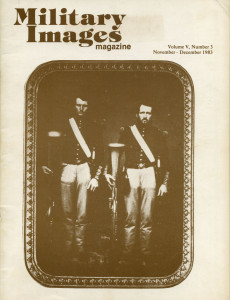The complete issue
Vol. V, No. 3
(32 pages)
Print edition: Visit our store to check availability
Digital edition: Visit JSTOR.org to purchase
Subscribe to MI
Explore the MI Archives: Browse | Advanced search | Tutorial
Inside
Cover image
The quarter-plate ambrotype on the cover of Military Images features two members of the Manchester, New Hampshire Brass Band with five-valve E-flat bass over-the-shoulder saxhorns. The image was taken in about 1855 and the instruments featured are exceptionally rare.
Editor’s Desk (p. 1)
The editor recounts how he met fellow “Civil War nut” Mark Elrod, writer of the featured article on Civil War bands and musicians, during their service in Vietnam.
Passing in Review (p. 2)
The first of two reviews is of How the North Won: A Military History of the Civil War by Herman Hattaway and Archer Jones. Different than many books that provide a chronology of events, this work looks more closely at the leading personalities as well as the strategies and economic foundations of the war. The second work is Stephen W. Sears’ work Landscape Turned Red: The Battle of Antietam. The reviewer felt that the first five chapters were not new, but gave high praise to the remainder of the book, which looks at Antietam through the regimental and brigade levels, giving new insight into the events of that bloodiest of days.
Mail Call (p. 3)
Among the letters that praised past articles and requested information from other readers, the editor provided insight into the service of Bucktail soldier Private William Pitts. A letter also credits Military Images with bringing attention to the story of Mary Tepe and announces that the interest has led to the discovery of her grave and the decision to replace her headstone, as “the old one was worn nearly smooth.”
The Shrill of Fifes, the Beat of Drums compiled by Don Murphy (pp. 4-15)
A pictorial with 38 images provides readers of Military Images with individual and group images of military musicians and bands from the era of the Indian Wars through World War One. Three of the images are of Robert Hendershot, 8th Michigan Infantry, who was wounded during the Battle of Fredericksburg at age 13; two are Civil War era cartes de visite while the third is from later years in the National Guard. Other images of small boys who served with fife or drum or bugle are presented, along with some images of children who were far too young to serve, but dressed the part for patriotic images. Some of the notable images are of a young woman who appears to be a vivandiere with her drum, a 1908 example of how daily bugle calls were amplified, a small group of Spanish-American War musicians with their gear (one wonders how the tuba player managed his instrument with his bed roll), and a “jazz band” from World War One, complete with mandolins and guitar.
Military Bands and Bandsmen, 1861-1865 by Mark Elrod (pp. 16-29)
Beginning with a history of bands prior to the outbreak of the Civil War, the reader learns about the development of brass instruments, which were key elements to military bands of the mid-nineteenth century. Many units of the war were developed right out of small communities across the North and South, and local bands were a part of that. They would join local militia as bandsmen, and held non-combat roles which explains why so many young boys (some as young as age 10 or 11) were in uniform. These “regimental bands” were in existence between April 1861 and August 1862, and were comprised of 24 members led by a member with the “title” of colonel. In order to reduce the cost of maintaining regimental bands, the Union Army officially only supported bands at the brigade level or higher. Regiments could get around this by enlisting their band members as combatants and then having them play. The article also discusses instruments, such as the OTS (over the shoulder saxhorn) instruments. Their unique positioning of the instrument bells allowed the sound to project backwards towards the troops so they could hear the music. Although allowed as many as 24 musicians, many bands had fewer members and were almost exclusively comprised of brass and drum instruments. The eighteen images that follow show a variety of bands and band members, including two images of the valve construction common at the time. Two rare composite photographs, one of the Federal 1st Brigade Band, 3rd Division, 15th Army Corps (from Brodhead, Wisconsin) and one of the Confederate band of the 5th Virginia Infantry (from Staunton, Virginia), are also presented, showing each individual member. The article closes with a modern image of the author, wearing a Marine band uniform with an OTS E-flat bass saxhorn.
Back Image
Pvt. Daniel W. Elliott of Rhode Island poses for a carte de visite image with violin.





































